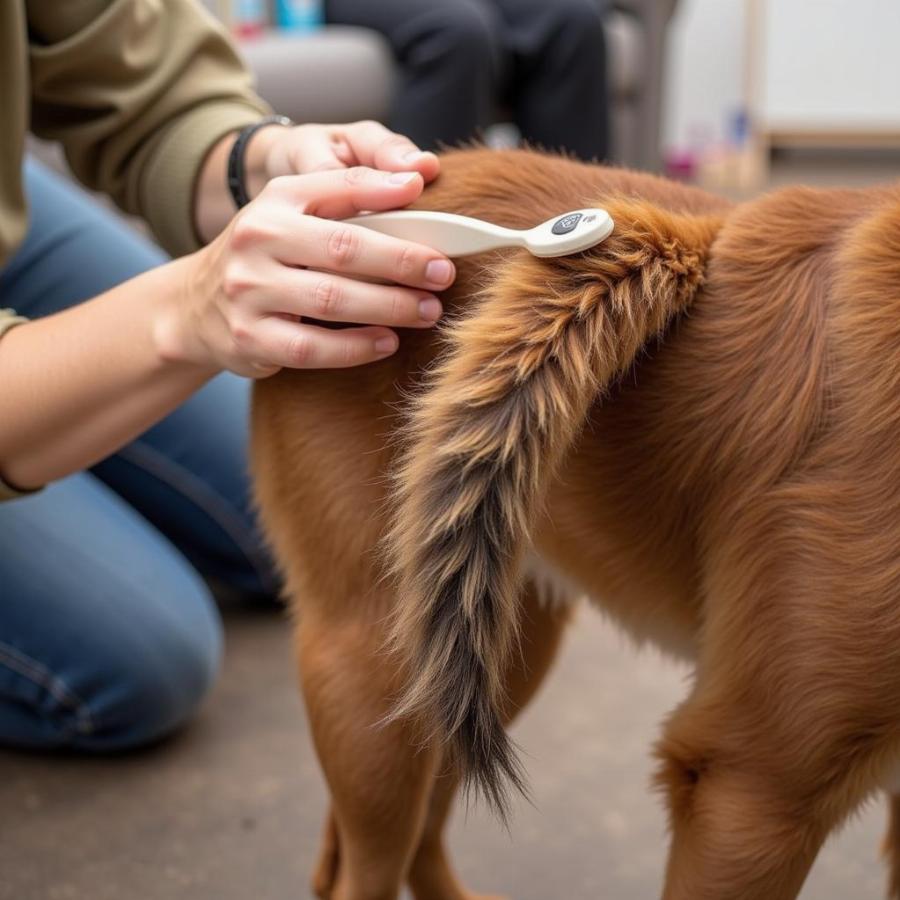The fascinating world of large dog breeds with curly tails offers a captivating blend of strength, grace, and a unique charm. But what does a curly tail signify in a large dog? Does it indicate a specific breed, temperament, or health condition? This comprehensive guide dives deep into the “large dog curly tail” phenomenon, exploring the breeds that commonly exhibit this trait, the possible reasons behind it, and what it means for owners.
Decoding the Curl: Why Do Some Large Dogs Have Curly Tails?
Several factors can contribute to a curly tail in large dogs. Genetics plays a significant role, with certain breeds predisposed to this trait. Sometimes, a curly tail is simply a natural variation within a breed, adding to its individual character. Other times, it can be linked to specific genes responsible for tail shape. However, it’s essential to differentiate between a naturally curled tail and one caused by injury or health issues.
Breeds Boasting the Beautiful Curl
Several large dog breeds are known for their characteristic curly tails. The striking Chow Chow, with its lion-like mane and tightly curled tail, is a prime example. Other notable breeds include the Shiba Inu, Akita, and certain Spitz varieties. These breeds often share a common ancestry, which might explain the prevalence of curly tails. best swimming dogs are not necessarily known for their curly tails, but some individuals might exhibit this trait.
Spotting the Curl: Identifying Breeds by Tail
While a curly tail can be a strong indicator of certain breeds, it’s crucial to avoid solely relying on this feature for identification. Many mixed-breed dogs might also exhibit a curly tail without belonging to any of the breeds typically associated with this trait. Therefore, it’s always recommended to consider other physical characteristics and consult with a veterinarian or breed expert for accurate identification.
Curly Tail Care: Tips for Keeping it Healthy
Caring for a curly tail requires no special treatment beyond regular grooming practices. Keeping the area clean and dry can prevent infections or skin irritations. For breeds with thick, double coats, like the Chow Chow, regular brushing is essential to prevent matting and tangles, especially around the tail area.
Grooming Guidelines for Curly-Tailed Canines
Regular brushing helps maintain the hygiene and beauty of a curly tail. Be gentle when brushing to avoid pulling or tugging, especially if the tail is tightly curled. Use a brush suitable for your dog’s coat type, and consult a groomer for advice on specific grooming techniques.
Beyond the Aesthetics: Does a Curly Tail Impact Health or Temperament?
A naturally curly tail in large dogs generally does not indicate any health concerns or temperament issues. It’s simply a physical trait inherited from their lineage. However, it’s vital to monitor for any sudden changes in tail shape or behavior, which could signal an underlying problem. good swimming dogs can have various tail types, and a curly tail doesn’t necessarily affect their swimming ability.
Common Questions about Curly Tails in Large Dogs
-
Does a curly tail affect a dog’s balance? No, a naturally curled tail does not impact a dog’s balance or coordination.
-
Is a limp tail the same as a curly tail? No, a limp tail typically indicates a medical condition or injury, while a curly tail is a natural trait. dogs that look like pug might have curly tails, but they are distinct from breeds with naturally curled tails.
Expert Insights: A Veterinarian’s Perspective
Dr. Emily Carter, a renowned veterinarian specializing in canine genetics, shares her insights: “A curly tail is often a defining characteristic of certain breeds, adding to their unique appearance. While generally harmless, it’s important for owners to be aware of any changes in tail carriage or mobility, as these could indicate a potential health issue.”
Conclusion: Embracing the Charm of the Curl
The curly tail in large dogs adds a touch of whimsy and distinction to these magnificent creatures. Whether it’s a tight curl or a gentle curve, this unique trait is part of what makes each breed special. By understanding the genetics and care behind the curl, we can better appreciate the beauty and individuality of our large, curly-tailed companions. clifford big red dog theme song celebrates the joy of having a large dog, and a curly tail only adds to their charm.
FAQ: Your Curly Tail Queries Answered
- What breeds have naturally curly tails? Chow Chows, Shiba Inus, Akitas, and some Spitz breeds.
- Should I be worried if my dog’s tail suddenly becomes less curled? Consult a veterinarian to rule out any underlying medical issues.
- Can a curly tail be straightened? Attempting to straighten a naturally curly tail is not recommended and could harm the dog.
- Does a curly tail affect a dog’s ability to communicate? No, dogs primarily communicate through body language, vocalizations, and scent.
- How do I groom a curly tail? Regular brushing is key, especially for double-coated breeds.
- Is a curly tail a sign of inbreeding? Not necessarily, it’s a breed characteristic in many cases.
- Are dogs with curly tails more prone to certain health problems? No, a naturally curly tail is not linked to specific health issues. dog clippers poodles are useful tools for grooming, but they require careful handling, especially around sensitive areas like the tail.
 Chăm sóc chó lớn đuôi xoắn
Chăm sóc chó lớn đuôi xoắn
Beaut Dogs is your go-to resource for all things related to dog breeds, offering expert advice on care, training, and finding the perfect canine companion. For personalized support, contact us at Email: [email protected]. Beaut Dogs is committed to providing accurate and reliable information to help you create a happy and healthy life for your furry friend. Visit https://beautdogs.com today to explore our vast library of resources.